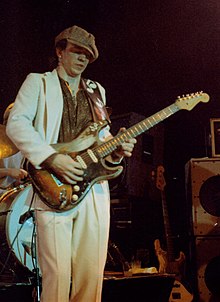Stevie Ray Vaughan | |
|---|---|
 Vaughan performing at the Ritz Theater in Austin, Texas, March 1983 | |
| Born | Stephen Ray Vaughan October 3, 1954 Dallas, Texas, U.S. |
| Died | August 27, 1990 (aged 35) East Troy, Wisconsin, U.S. |
| Cause of death | Helicopter crash |
| Resting place | Laurel Land Memorial Park, Dallas 32°40.417′N 96°48.771′W / 32.673617°N 96.812850°W |
| Other names | Stevie Vaughan, SRV |
| Education | Justin F. Kimball High School |
| Occupation(s) | Musician, singer, songwriter |
| Spouse |
Lenora Bailey
(m. 1979; div. 1988) |
| Partners |
|
| Relatives | Jimmie Vaughan (brother) |
| Awards | List of awards and nominations |
| Musical career | |
| Genres | |
| Instruments |
|
| Years active | 1965–1990 |
| Labels | |
| Formerly of |
|
| Website | srvofficial |
| Signature | |
Stephen Ray Vaughan (also known as SRV; October 3, 1954 – August 27, 1990) was an American musician, best known as the guitarist and frontman of the blues rock trio Stevie Ray Vaughan and Double Trouble. Although his mainstream career spanned only seven years, he is regarded as one of the most influential musicians in the history of blues music, and one of the greatest guitarists of all time. He was the younger brother of guitarist Jimmie Vaughan.
Born and raised in Dallas, Vaughan began playing guitar at age seven, initially inspired by his brother Jimmie. In 1972, he dropped out of high school and moved to Austin, where he began to gain a following after playing gigs on the local club circuit. Vaughan joined forces with Tommy Shannon on bass and Chris Layton on drums as Double Trouble in 1978. The band established itself in the Austin music scene and soon became one of the most popular acts in Texas. They performed at the Montreux Jazz Festival in July 1982, where David Bowie saw Vaughan play. Bowie contacted him for a studio gig in December where he played blues guitar on the album Let's Dance (1983). John Hammond heard a demo album that Vaughan and Double Trouble had recorded and interested major label Epic Records in signing them to a record deal in March 1983. Within months, they achieved mainstream success for the critically acclaimed debut album Texas Flood. With a series of successful network television appearances and extensive concert tours, Vaughan became the leading figure in the blues revival of the 1980s.
Vaughan struggled with alcoholism and drug addiction for most of his life. He also struggled with the personal and professional pressures of fame and his marriage to Lenora "Lenny" Bailey. He successfully completed rehabilitation and began touring again with Double Trouble in November 1986. His fourth and final studio album In Step reached number 33 in the United States in 1989; it was one of Vaughan's most critically and commercially successful releases and included his only number-one hit, "Crossfire". He became one of the world's most popular blues performers, and he headlined Madison Square Garden in 1989 and the Beale Street Music Festival in 1990.
On August 27, 1990, Vaughan and four others were killed in a helicopter crash in East Troy, Wisconsin, after performing with Double Trouble at Alpine Valley Music Theatre. An investigation concluded that the cause of the accident was pilot error. Vaughan's music continued to achieve commercial success with several posthumous releases and has sold over 15 million albums in the United States alone. Rolling Stone has twice ranked him among the top twenty guitar players of all time. Vaughan was posthumously inducted into the Rock and Roll Hall of Fame in 2015, along with Double Trouble bandmates Chris Layton, Tommy Shannon, and Reese Wynans.